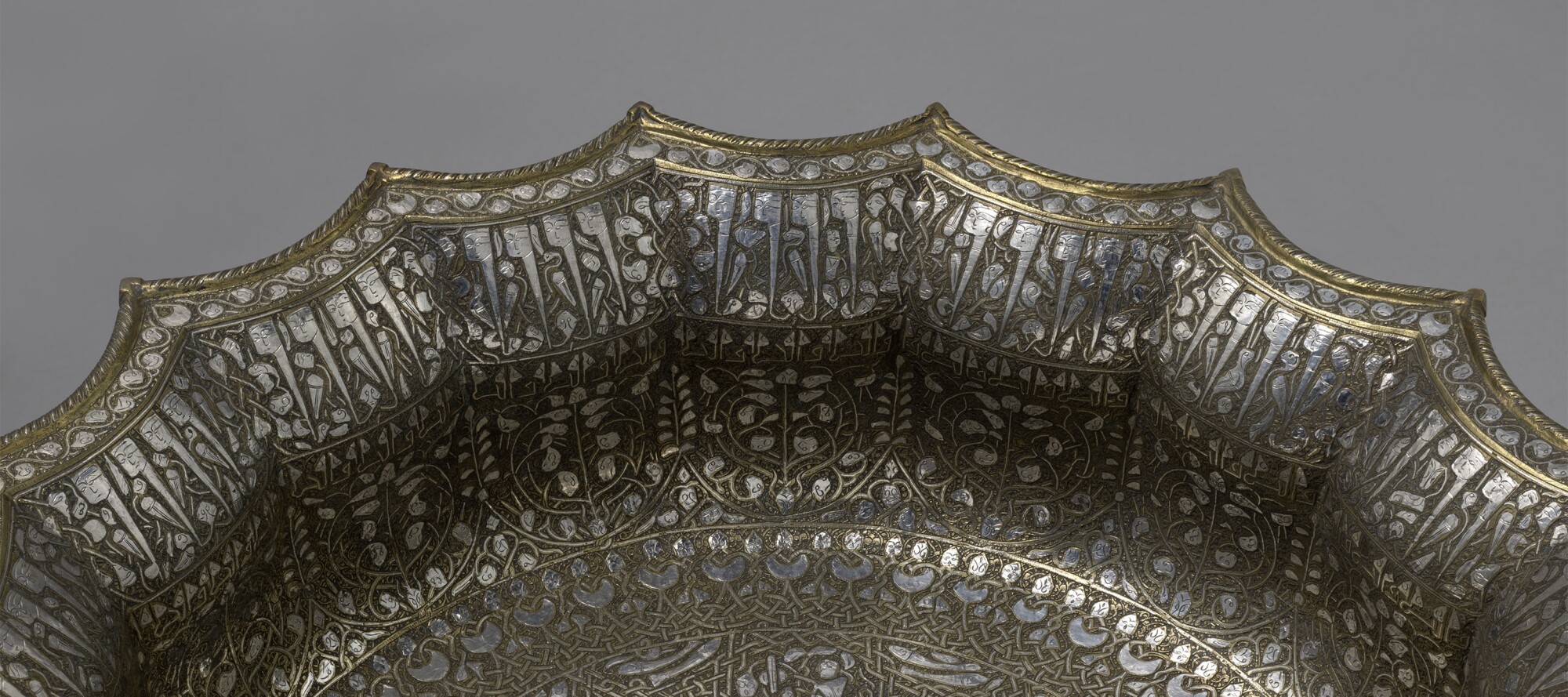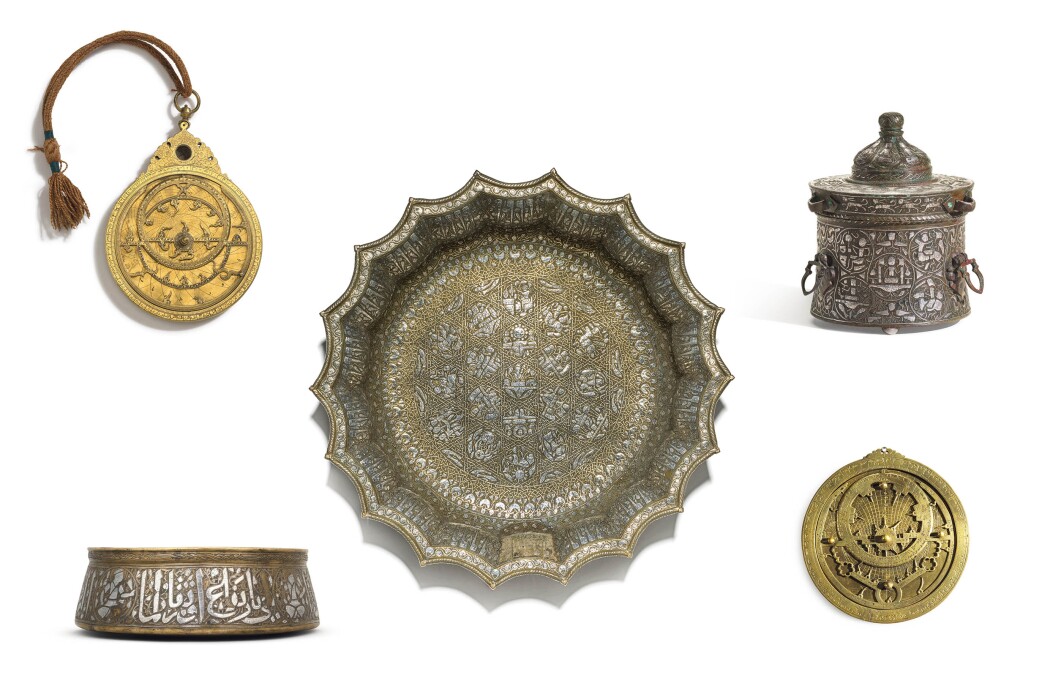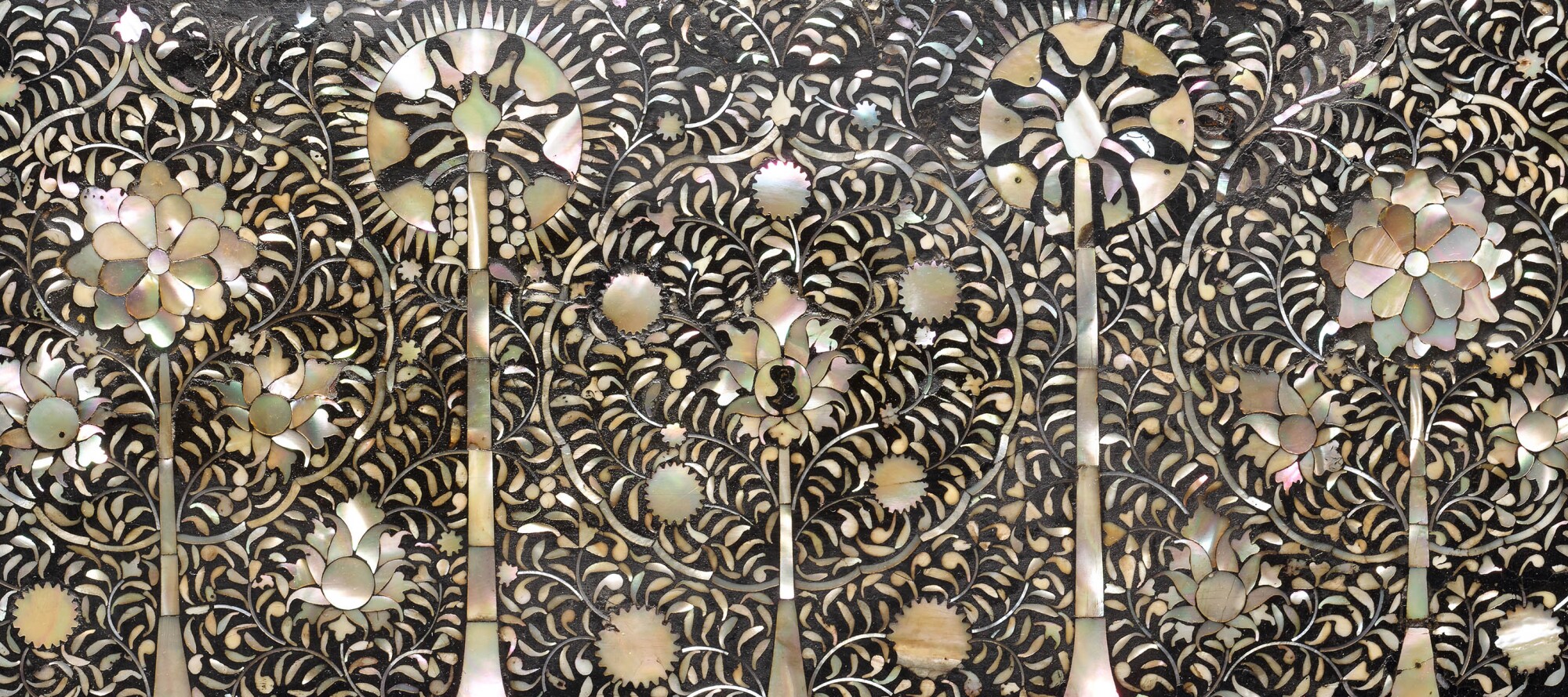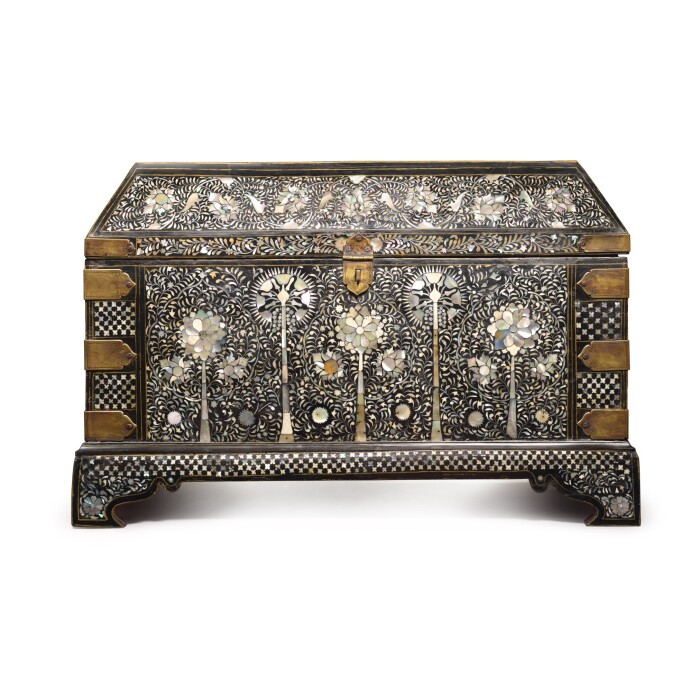S otheby’s spring sale of Arts of the Islamic World & India celebrates the production of art works, paintings and manuscripts from across the Islamic World.
Appearing for the first time at auction is a magnificent twelfth-century silver-inlaid scalloped basin from Herat with a complex astrological design comprising zodiacal and apotropaic symbols.
Leading the section of Fine Rugs and Carpets is an extremely rare sixteenth-century Safavid niche prayer rug from Central Persia.
Featured Highlights

Astronomy and astrology were considered related disciplines by scientists of the Islamic World. The developments in the field of astronomy, notably through the refinement of sophisticated astrolabes, was partly encouraged by the religion’s requirements: Muslims pray towards Mecca at specific times each day, as well as the need to determine fasting times during the month of Ramadan from sunrise to sunset as well as the beginning of a new moon.
Sotheby’s is delighted to include two important astrolabes, one from tenth century Spain and the other hailing from seventeenth century Persia. These were intended to be two-dimensional representations of the three-dimensional celestial sphere and could be used to determine the motion of the heavens and measure time. Certain plates were included for specific localities, and some included the direction to Mecca using the qibla.


The base of the bowl is particularly noteworthy as it depicts the sun surrounded by six roundels containing figures, each personifying one of the known celestial bodies of the time.
It shows the continuation of this tradition of depicting the planetary personifications into the 14th century – from Iran to Egypt…
This inkwell is in remarkably good condition, retaining most of its original inlay and with many of the incised details in the inlay still discernable.

One of the most prominent motifs on this inkwell is the enthroned figure of Jawzhar between a pair of dragon-headed staves.

Jawzhar is the pseudo-planetary figure responsible for the lunar and solar eclipses.
He originates from the Hindu deity Rahu whose attribute is the severed head of a dragon - Rahu had sipped from the drink bestowing immortality, amrita, against the wishes of the Gods. Denounced by the sun and the moon, Vishnu severed his head. But now immortal, his head and body remained to seek vengeance against the sun and moon. Whenever they might, the two parts of Rahu attempt to devour the sun and the moon and thereby cause sola and lunar eclipses, respectively
This basin is not only one of the most magnificent surviving examples of Herati silver-inlaid metalwork of the twelfth/thirteenth century but also a prime example of how astrology is harnessed both for protection and as an expression of power. The iconography reveals a complex knowledge of astrology and a belief at the highest level of both the apotropaic and governing influence of the stars.
This gilded brass astrolabe of is signed by Aḥmad ibn Abī ʿAbdallāh al-Qurṭubī al-Yamānī in Tudela in 737 Hijra, that is, 1336/37.
The maker was previously unknown and of Yemeni origin
This is the only known medieval astrolabe from Tudela, a city divided between three religious communities at that time

The inclusion of a set of universal markings on the other side of the one plate (out of two) left, would have served the latitude of Tudela, which is about 43° (most Andalusî astrolabe plates include Saragossa, but none have Tudela)
This elegant astrolabe was made by two of the leading instrument-makers of Safavid Iran in the mid-seventeenth century

This astrolabe was made for an important Safavid theologian, Mirza Razi al-Din Muhammad al-Husayni al-Musawi
Parallelly, astrology developed as a study of the influences of the celestial bodies on earth and which could be used in predictions. The role of planets being fundamental in the study of astrology, personal attributes were ascribed to each and to the stellar constellations forming the Zodiac. The three objects presented here include a monumental basin and an inkwell from circa 1200 Herat as well as a Mamluk fourteenth century bowl, each with an iconographic design based on the planets and the Zodiac. These lots carry the important symbolism associated with both the studies of astronomy and astrology and are witnesses connected nature of our Heavenly and Earthly spheres.
(For an account of spherical astronomy and astronomical timekeeping in Islam, see D. A. King, In Synchrony with the Heavens, Studies in Astronomical Timekeeping and Instrumentation in Medieval Islamic Civilization (3 volumes), 2003-2005).
From the Collection of Viscount and Lady D'Abernon: Ottoman Velvets
Sotheby’s is delighted to present five Ottoman velvets once belonging to the distinguished collection of Edgar Vincent, 1st Viscount d’Abernon (1857-1941). These textiles are evocative of the richness and diversity of luxury textile production at the height of the Ottoman Empire.
Created in government-controlled workshops in the late sixteenth and seventeenth centuries, notably in the small town of Bursa, silk products were amongst the Empire’s greatest manufacturing achievements and an important source of pride and prestige. Such textiles played a key role in Ottoman society as indicators of rank and status. Initially conferred on the courtly class, the slow decline of the Empire meant that luxury textiles became available on the open market in the late-nineteenth and early-twentieth centuries offering opportunities for collectors.

It was most probably during his time as Governor of the Imperial Ottoman Bank in Istanbul between 1889-1897 that Lord d’Abernon would have acquired these textiles. Both he and his wife, Lady Helen Venetia Duncombe, were avid collectors and art lovers. Together they purchased the Palazzo Giustinian in Venice, a fifteenth-century Venetian Gothic building which they filled with art and fine fabrics. An evocative painting by the artist John Singer Sargent (1856-1925) depicts Lady d’Abernon in Venice in 1904 with a warm red textile behind her suggestive of the rich interior into which textiles such as these would have fit so well, resembling paintings (see Birmingham Museum of Art, inv. no. 1984.121).
The present group features tulips, rosettes, carnations, palmettes, all of which belong to the favoured repertoire of flowers at the Ottoman court. Four of the textiles are bound by a similar lattice which at once contains further motifs and links the central design to create a unified visual field. Sometimes this lattice is joined together by a cintamani motif, a crown or a frontal rosette.

These details, such as the weighty band of the lattice and the large-scale of the plants is Italianate in style and speaks to the cross-cultural influences between these two civilisations. During the second half of the fifteenth century several Italian city states such as Venice, Florence and Genoa were famed for their superb polychrome multi-level pile velvets. They were so highly prized at the Ottoman court that Istanbul became the largest single export market for luxury Italian textiles, despite the existence of Imperial velvet weaving workshops in Bursa.
One can understand the appeal of such textiles which were both Ottoman and Italianate, painterly and textured, to cosmopolitan travellers and art collectors who divided their time between Istanbul and Venice.


- Technique
The mother of pearl was cut into fine minute sections which were overlaid on a mastic ground to create a fluid vegetal design. This is a technique associated with the capital city of Ahmedabad.
- Material
The mother-of-pearl used on this casket most probably came from the shell of the turbinella marmoratus. Mainly found in the Indian ocean, these shells are known for their pinkish hue.
- Design
Caskets such as this would have been produced for the export market and mainly traded by Portuguese merchants but records indicate that Gujarati mother-of-pearl wares were being imported to Europe from as early as the second quarter of the sixteenth century and found their way in various European Royal treasuries.
- Interior

The interior is vividly painted with birds amidst floral foliage, it has survived remarkably and is rare to see on such caskets.
- Rarity
The present piece represents a rare addition to a corpus of less than ten known caskets of identical form.
- Vegetation
The tall palm trees and flowering trees surrounded by lace-like vegetation on this chest recall the extraordinary window jalis of the Sidi Saiyyed mosque in Ahmedabad.

Sidi Saiyyed Mosque, Vrajesh jani, CC BY-SA 3.0, via Wikimedia Commons Constructed in 1573 under Mughal rule, this monument is iconic of the last Gujarat Sultanate, and one cannot help but imagine that the craftsmen of this chest would have been directly inspired by its design.
Masterpieces of Calligraphy
The rugs and carpets in this auction feature an important Safavid niche rug embellished with silver metal thread, from the so-called ‘Salting’ or ‘Top Kapi’ group (lot 138). From a European Private Collection and never previously offered for sale, it is one of the rare sub-set of this group with Shi’ite inscriptions. Some thirty five of these rugs remain in the Top Kapi, many apparently never having been used since they were either taken as booty or gifted, since they remain in bright, unworn condition.
Several pieces related to these rugs joined private and museum collections in the late 19th century and early 20th century, probably having been sold from the Top Kapi during the chaos of the Russo-Turkish War of 1877-1878, when the Russians had almost reached Constantinople. This is one of ten pieces with cloudbands, thought to be amongst the earliest; the drawing and proportions of this piece being arguably the most elegant. Six are in museums, one is missing and three, including this one, remain in private hands.
These rugs also provided inspiration for the weavings of the Kum Kapi workshops in Istanbul, established in the late 19th century, and lot 139, a so-called ‘Sultan’s Head’ rug woven in silk and metal thread brocading is a good example of this exchange.
Also in the auction is the fourth part of a private collection formed over 30 years which Sotheby’s has been privileged to offer, including examples from all the important weaving centres of classical rug production: this selection includes the early 17th century Marquand ‘Animal’ rug (lot 162), named for an earlier owner, the famous American collector Henry G Marquand; a good 17th century Isphahan small carpet (lot 161), and a yellow-ground ‘Transylvanian’ niche rug with green-ground ‘Gothic’ border previously with David Halevim (lot 147). Other property includes a rare Bokhara susani with unusual large yellow ‘pom-pom’ roses (lot 183).







































